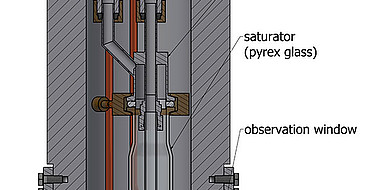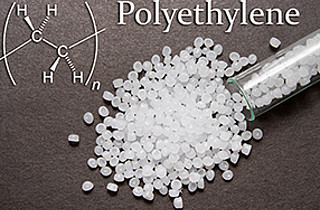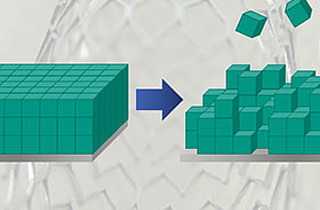High-pressure saturator for process engineering
In process engineering, saturator systems are used to selectively enrich carrier gases with liquid substances up to their vapor pressure so that the mixture can be further processed in the gas phase. This technology is used primarily in the semiconductor and coating industries.
State of the Art
Commercial saturators are usually made of stainless steel or glass and are usually designed for a maximum pressure of 20 bar. For a wide variety of processes, material-flexible and pressure-stable saturators would be advantageous. However, both variants show their weaknesses here: saturators made of stainless steel can be operated at higher pressures, but are unsuitable for highly corrosive or catalytically sensitive substances. Here there is a risk of corrosion damage and material contamination in the process. Glass vessels, on the other hand, are not pressure-stable.
Technology
Using a new reactor principle, KIT researchers have succeeded in decoupling the material selection of the saturator vessel from the pressure stability and thus being able to provide corrosive liquids in the gas phase under very high carrier gas pressure. The reactor consists of a saturator vessel (bubbler) with a temperature control unit and a high-pressure housing. The high-pressure housing encloses the saturator vessel. Pressure equalization between the two components is ensured by means of control valves. The internal pressure in the saturator is thus equal to the external pressure in the high-pressure vessel, so that the internal, pressure-sensitive saturator vessel does not have to withstand any pressure differences. The material selection of the vessel can be based exclusively on the chemical requirements.
Advantages
The two-part reactor allows the use of almost any vessel material, even for gas-liquid reactions. Due to the "vessel in vessel" principle, the reactor can be flexibly adapted to the requirements of the individual application: For example, the shape, wall thickness, material or closure technology can vary. The principle of the high-pressure vessel with pressure equalization is essential, especially when the reactor pressure is significantly higher than ambient pressure.
Options for companies
In an exemplary application with high-purity nitric acid, the principle for high-pressure saturation up to a pressure of 100 bar was tested at the institute; a prototype of the saturator is available. The basic principle can be adapted to other liquids and reactor designs. KIT is looking for partners to use the technology under license.
Your contact person for this offer

Innovation Manager New Materials, Climate and Environment Karlsruhe Institute of Technology (KIT)
Innovation and Relations Management (IRM) Phone: +49 721 608-26107
Email: jan-niklas.bloetz@kit.edu



